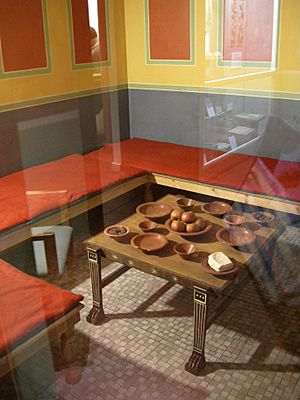Canterbury Roman Museum facts for kids

Entrance in Butchery Lane, Canterbury
|
|
| Established | 1961 1994 after refurbishment |
|---|---|
| Location | 11a Butchery Lane, Canterbury, Kent, CT1 2JR |
| Type | Scheduled monument, heritage centre |
| Collection size | Roman pavement; excavated Roman artefacts |
| Public transit access | Rail: Canterbury West; Canterbury East Buses: National Express, Stagecoach |
The Canterbury Roman Museum is an exciting place in Canterbury, Kent, where you can discover the incredible history of the Romans in Britain! It's built around a real Roman pavement that is more than 1,700 years old. This special pavement is part of an ancient Roman house. It is so important that it is protected as a scheduled monument, which means it is a nationally important historical site. The museum also displays many cool things found during digs in Roman Canterbury, like the famous Canterbury Treasure – a collection of silver items! The museum first opened its doors in 1961.
Contents
History of Roman Canterbury
The Roman Town of Durovernum
Around the year 43 AD, the Romans arrived in Britain. They captured a settlement near the River Stour that belonged to a local tribe called the Cantiaci. The Romans renamed this place Durovernum Cantiacorum. This name meant "stronghold of the Cantiaci by an Alder marsh."
The Romans designed their new town with a grid pattern of streets. They built important public buildings like a theatre, a temple, a forum (a public square), and baths. By the late 200s AD, the town was protected by a strong wall with seven gates. This wall helped defend against attacks. The town covered a large area, about 130 acres.
Life in Roman Canterbury
Roman Canterbury was at its busiest and most developed around 300 AD. The Roman house that holds the famous pavement was surrounded by these important public buildings. For example, parts of a large Roman theatre were found under nearby streets. Also, big public baths were discovered under modern buildings.
The Roman townhouse with the pavement was likely used until about 410 AD. This was when the Roman government left Britain.
Discovery of the Roman Pavement
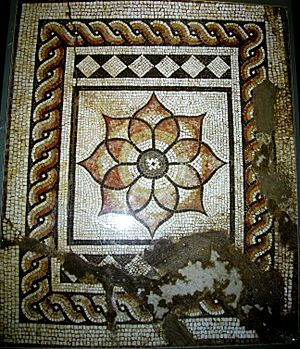
The amazing Roman pavement was found after a bombing during World War II on June 1, 1942. Archaeologists Audrey Williams and Sheppard Frere carefully dug up the site between 1945 and 1946. People were allowed to visit the site starting in 1946, and even royalty came to see it!
More digging happened between 1958 and 1961. This led to the creation of the Roman Pavement Museum right above the discovery. The museum was updated and reopened as the Roman Museum in 1994. It is now a Grade I listed building, meaning it is a very important historical structure.
The museum helps people understand what the Roman city was like. It shows the secret city hidden beneath the ground. As you walk down into the museum, each step represents 100 years of history. This takes you down to the 300 AD level where the pavement is.
Museum Exhibits
The Mosaic Pavement
Over many centuries, the ground level in Canterbury has risen. This means the Roman pavement is now underground. You can see it exactly where it was found, in situ. The pavement is part of a Roman town house and includes a hypocaust (an ancient Roman underfloor heating system).
The official description of the pavement says it has "three mosaic panels which decorate the remains of a corridor of a Roman house." It dates from around 300 AD. A special air conditioning system helps keep it preserved.
Excavated Artifacts
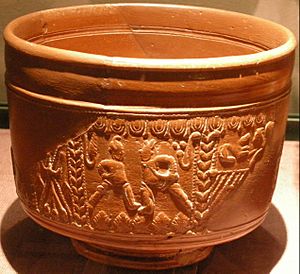
The museum displays many objects found during digs. You can see household deities, including one shaped like a horse. There is also a lot of Roman glass, some of it beautifully decorated. Other items include silver spoons, an axe, tweezers, a plumb weight, and dice.
A special collection is the 5th-century AD silver hoard. This treasure was found in Westgate Gardens in 1962. Military items are also on display. These include metal parts of cavalry harness that have been put back together. There are also two cavalry swords, called spathae, found in a double burial. You can also see roof tiles and floor tiles, one even showing a dog's footprints!
Reconstructions and Displays
The museum has recreated parts of a Roman house, including a kitchen. There is also a Roman market place, probably located in the forum. Here you can see a cobbler, a haberdasher (someone who sells small sewing items), a greengrocer, and a fast food seller. The cobbler exhibit is based on real leather pieces found by archaeologists. These pieces were cut out for making sandals. You can see the original leather pieces and how the sandals were made.
A computer screen shows what the Roman house might have looked like. It also shows images of the pavement being dug up. A "time-tunnel" display explains how the Roman occupation of the town ended. A large painting shows Roman Canterbury in later periods.
Interactive Fun
The museum has interactive features to make learning fun. An interactive screen lets visitors explore the Temple site of Roman Canterbury. Before you leave, you can even handle real Roman artifacts! A guide helps you identify the objects. There are also "Make your own magnetic mosaics" and "Dress like a Roman" activities. These are great for all ages.
Museum's Future
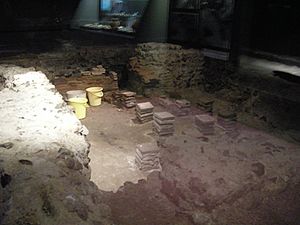
In 2009, there were worries that the museum might close. This caused a lot of discussion. The Canterbury City Council decided in 2010 to fund the museum for another year. They worked with other groups to find ways to keep it open. The good news is that the situation was resolved, and the museum is still open for everyone to enjoy!
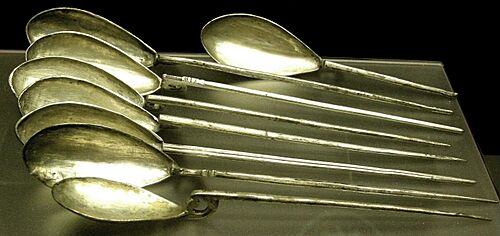
See also




